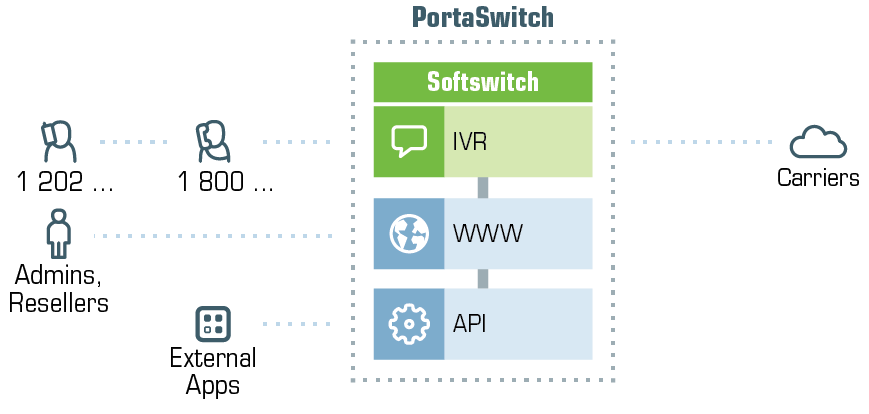In the case of WiMAX, PortaBilling does not directly communicate with any of the base stations; instead, it communicates via the RADIUS protocol with WiMAX ASN-GW.
User authentication
PortaBilling supports WiMAX user authentication via EAP-TLS (this method relies on the certificate provided in the CPE) or EAP-TTLS (this method requires the CPE to have a valid username/password combination). Authentication also includes generation of the WiMAX session key and other required processing.
Flow provisioning
PortaBilling may return optional attributes to provision service flows for the user’s WiMAX session.
Bandwidth provisioning
The administrator may define the allowed download/upload bandwidth as part of the product configuration in PortaBilling. Then during the service flow provisioning mentioned above the required information will be returned to the ASN gateway, and so will be applied to the session.
Hotlining
If a user is not allowed to use the WiMAX service (insufficient balance, customer blocked, account’s product does not include the WiMAX service or some other problem), instead of returning an authentication reject PortaBilling may allow the session to be established but will assign a specific hotline profile to it. When the end user tries to browse the Internet, he will automatically be redirected to a separate web page informing him about the status of his account.
Session monitoring
When a WiMAX session becomes active, ASN-GW sends a start accounting request to PortaBilling, informing it that the customer is now online. This information is stored in PortaBilling, so that the administrator can see information about currently active sessions on the PortaBilling web interface.
Real-time processing of service usage
When a customer is connected to a WiMAX network, ASN-GW periodically sends interim (also called keep-alive) accounting requests with information about the currently consumed amount of service – for instance, the total number of bytes downloaded. Upon receiving an interim accounting request, PortaBilling updates the internal tables for service usage (so the administrator and the end user can see up-to-date statistics) and re-calculates the applicable charges for this session. Thus the charges are immediately deducted from the available balance or (in case of quota enforcement) the session is disconnected almost immediately after the quota is reached.
Postpaid service
The postpaid model allows you to authenticate only those customers who are entitled to use the service and have their account in good standing. When a customer is blocked by the administrator, suspended because of non-payment, or exceeds his credit limit, a CoA (change of authorization) message will be sent to ASN-GW to terminate the current session or switch it to the hotlined state.
Prepaid service
Each new session is authorized based on whether the account has funds available for using the service. After receiving each interim accounting request, the charged amount for this session is recalculated and applied to the account’s balance. If there are no remaining funds, PortaBilling sends a CoA request to ASN-GW to terminate the current session or switch it to the hotlined state.
Data transfer quota enforcement
The PortaBilling administrator defines data transfer policies using a flexible tool – volume discount plans. This allows you to define the amount of data provided free of charge (at a 100% discount) and what happens after that: the service can be blocked, switched to a “limited” mode (low bandwidth), or the customer can be charged for data above the threshold.
Supported equipment
PortaBilling supports the generic set of WiMAX RADIUS attributes and may potentially be used for basic authentication and accounting of WiMAX sessions with all major WiMAX equipment vendors.
Provisioning of the flow attributes (or other proprietary attributes) requires vendor-specific interop. Please contact PortaOne to obtain more information about the currently supported vendors and equipment models.



